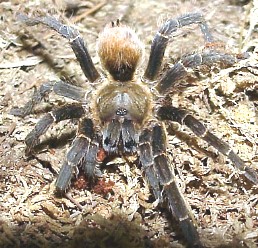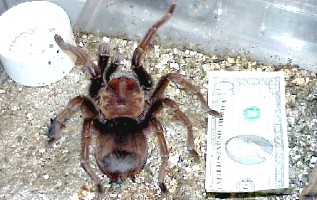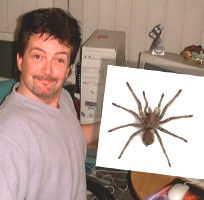|
The Goliath Birdeater, Theraphosa leblondi, is a tarantula, and it is the largest spider in the world. Despite its name, the Goliath Birdeater does not eat birds; it eats invertebrates such as crickets and mealworms, and also small vertebrates such as mice and lizards. Native to South America, these spiders can be as large as 30 centimetres (12 inches) in leg span, when their legs are stretched out. You can see an approximately life size photograph of this huge spider here. The Goliath Birdeater is one of the few tarantulas which can catch, kill, and eat a full-grown mouse. 
Spiders are high in protein! The Piaroha tribe in Venezuela collect Goliath Birdeater tarantulas and roast them over hot coals, eating them as if they were big hairy crabs ... carefully avoiding the large fangs and the poison sacs. The fangs are later used as toothpicks. Female Birdeaters have an average life span of 6 to 14 years. Males die soon after maturity, and have a lifespan of only 3 to 6 years. Colours range from dark to light brown, with faint markings on the legs. They have hair on the body, abdomen, and legs. The female lays anywhere from 100 to 400 eggs, which will hatch within two months. Young spiders are called 'spiderlings'. Wild Goliath Birdeaters are a deep burrowing species, found commonly in marshy or swampy areas. They may make a hissing noise when disturbed, and can defend themselves by biting, or by releasing their body hairs.
 |
